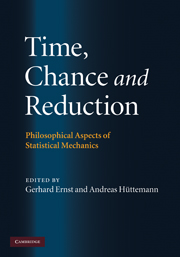10 - Irreversibility in stochastic dynamics
from Part III - Reduction
Published online by Cambridge University Press: 04 August 2010
Summary
Introduction
Over recent decades, some approaches to non-equilibrium statistical mechanics, that differ decidedly in their foundational and philosophical outlook, have nevertheless converged in developing a common unified mathematical framework. I will call this framework ‘stochastic dynamics’, since the main characteristic feature of the approach is that it characterizes the evolution of the state of a mechanical system as evolving under stochastic maps, rather than under a deterministic and time-reversal invariant Hamiltonian dynamics.
The motivations for adopting this stochastic type of dynamics come from at least three different viewpoints.
(1) ‘Coarse graining’ (cf. van Kampen, 1962; Penrose, 1970): In this view one assumes that on the microscopic level the system can be characterized as a (Hamiltonian) dynamical system with deterministic time-reversal invariant dynamics. However, on the macroscopic level, one is only interested in the evolution of macroscopic states, i.e. in a partition (or coarse graining) of the microscopic phase space into discrete cells. The usual idea is that the form and size of these cells are chosen in accordance with the limits of our observational capabilities.
On the macroscopic level, the evolution now need no longer be portrayed as deterministic. When only the macro-state of a system at an instant is given, it is in general not fixed what its later macro-state will be, even if the underlying microscopic evolution is deterministic. Instead, one can provide transition probabilities, that specify how probable the transition from any given initial macro-state to later macro-states is.
- Type
- Chapter
- Information
- Time, Chance, and ReductionPhilosophical Aspects of Statistical Mechanics, pp. 180 - 207Publisher: Cambridge University PressPrint publication year: 2010
References
- 1
- Cited by



